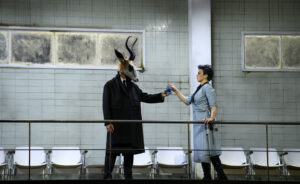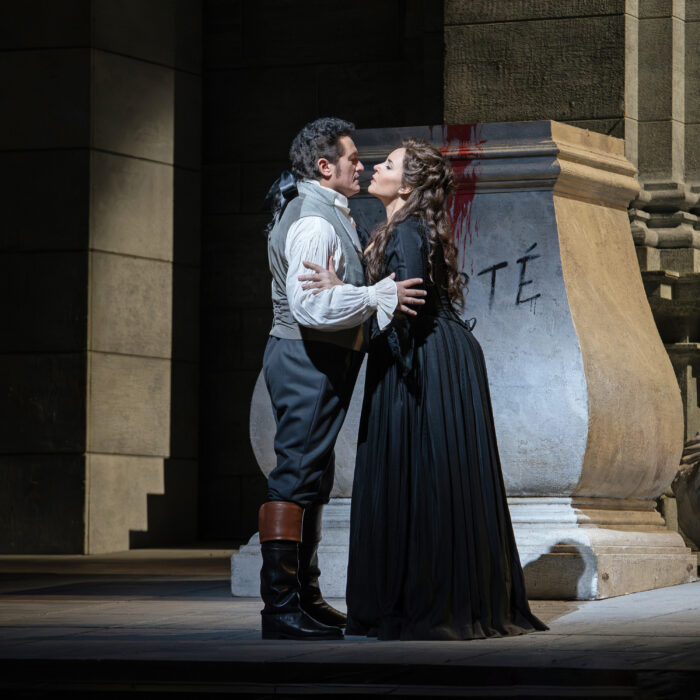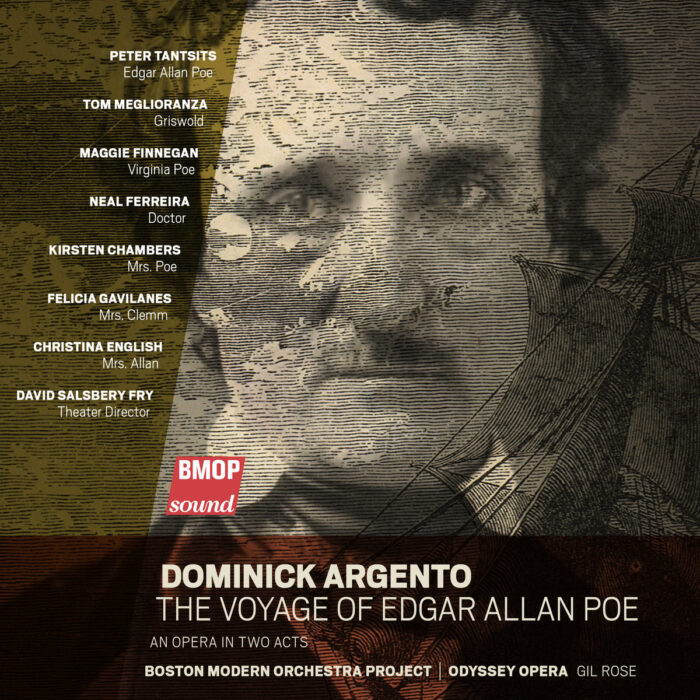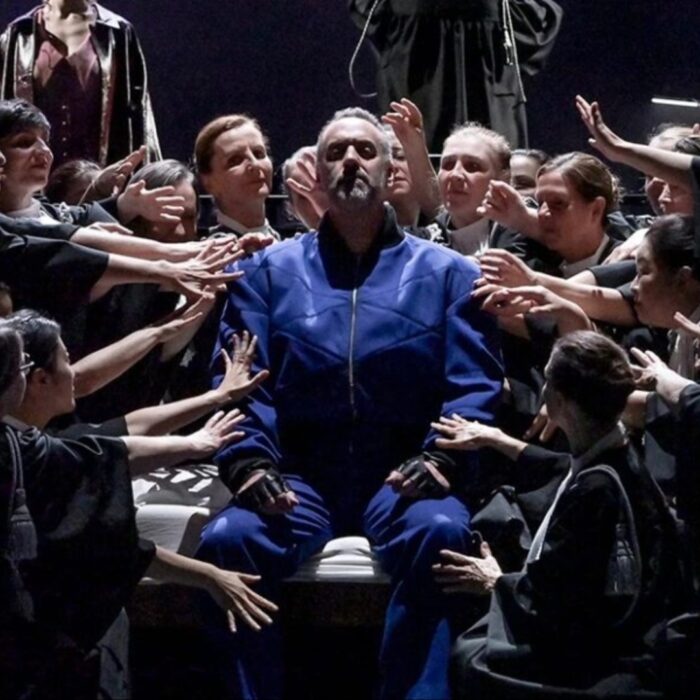
Dutch National Opera 2024-25 Review: Die Frau Ohne Schatten
Katie Mitchell’s Exciting But Controversial Reading
By Alan Neilson(Photo: Ruth Walz)
Like other fairytales, Richard Strauss’ opera, “Die Frau ohne Shatten,” with its cast of human and supernatural beings, otherworldly locations and a magical plot, makes use of symbols and metaphor to carry deeper messages and thus opens itself up to a wide range of interpretations. Katie Mitchell, the director for Dutch National Opera’s recent production, certainly took a bold approach, presenting it as a “feminist sci-fi thriller” to counter the misogyny that she sees as being “baked into the libretto…at every level,” citing the example that it “places the blame for childlessness squarely on the female partner, without any scientific substantiation.”
Mitchell’s Reinterpretation Ignores the Intentions of the Libretto
As it turned out, it was a reinterpretation rather than an interpretation, one that required fundamental changes to the narrative, in which Mitchell, on occasions, deliberately chose to work against the libretto. In her program notes, she justified her actions, stating that “when we drag an opera through time, we take with us…the toxic roots of misogyny, racism and ableism. If we do not address these roots in our staging, we risk not only perpetuating the original misogyny – but worse, actively propagating it.”
Some of her interventions were wholly reasonable in that they added to the dramatic strength of the work without going against the spirit of the libretto. Rather than having Keikobad remain as an invisible presence, for example, he appears in the flesh, overseeing and directing events, thereby bringing his relationship with his daughter, the empress, to the fore, which becomes the centre of the drama and which, simultaneously, explicitly identifies him as the patriarchal head, wielding absolute power, and responsible for everything that happens.
Other decisions, however, acted against the intentions of the text and were thus more controversial. Barak, for example, is no longer presented as a good man, unfairly treated by his untrustworthy wife. Rather, Mitchell reimagines the roles so that they are presented as a couple, sharing the problems of their marriage. Barak is envisioned as a depressed drug dealer who spends his time getting drunk with his brothers so that his wife’s behavior, although certainly not saint-like, becomes more understandable. She does not long for a lover as in the libretto but is threatened at gunpoint to take a stranger to father a child. Certainly, such treatment alters the dynamics and motivations of the work and cannot simply be accepted as an interpretative decision; it goes further than that. However, it definitely generated more exciting scenes with greater levels of tension, and if one agrees with Mitchell’s approach, its treatment of the relationship between the married couple becomes more acceptable.
There did, however, appear to be an element of gratuitous violence used to reinforce the idea that men in general are prone to this sort of behavior; in the final scene, for example, Barak and his wife and the empress and emperor are reunited, and there is general rejoicing, which, on its own, would have distracted from Mitchell’s feminist message. She therefore had the Nurse and Barak’s brothers shot dead on Keikobad’s orders; it was a powerful image that acted against any sense of rejoicing. Mitchell argues in her program notes that “good music will always be open to different emotional interpretations;” in this instance, however, it appeared that she was forcing her interpretation onto the music, which is a different thing entirely.
Putting to one side the rights and wrongs of Mitchell’s highly interventionist approach, the staging proved to be thoroughly engaging. She set out to turn “a somewhat slow fairy tale into a fast and violent thriller,” and that is exactly what she achieved. From the very beginning, a sense of menace hung over the stage, in which mafioso-type characters, some of whom were part animal, although no less threatening for the fact, engaged in acts of terror, including murder, abduction, forced sexual intercourse and medical procedures, behind which lay the sinister hand of Keikobad.
The sets, designed by Naomi Dawson, were expertly crafted to allow the “fast-moving thriller” to play out against a modern, recognizable background, consisting of rooms in the emperor and empress’ comfortable apartment on an upper level with Barak and his wife’s mundane house on a lower one. Over recent years, it has become a popular scenic device used by many designers; not only does it provide an immediate context for the drama without the need for frequent scene changes, but with multiple rooms, it allows for a greater degree of detail and depth that strengthens the dramatic effect. So, for example, when Keikobad’s goons enter Barak’s house, he and his wife are in the bedroom, allowing the audience to observe their increasing fear as they wait for Keikobad and his men to open the door and enter.
The set was functional, although not particularly imaginative, but that changed in Act three. Instead of Barak’s rooms and the emperor’s plush apartment, the curtain lifted to reveal the inside of a grim building with dark brown walls. On the upper level there was a balcony with cheap and nasty chairs and uninviting doors that one really did not want to enter. Keikobad stood against a rail, watching and directing events. Below was a dirty subterranean area with cell-like areas and a canal that ran along the back of the stage. The whole scene was intimidating and would not have looked out of place if used for a film about the Gestapo and gave the work a more disturbing and frightening appearance; the violence of the first two acts gave way to a far darker and menacing character, in which the rules of the human world no longer applied.
Dawson was also responsible for the costume designs. All the human characters were dressed in standard attire that reflected their social positions, so Barak and his drug-dealing brothers wore casual, inexpensive clothing, while the empress wore slightly better-quality casual wear. Keikobad, his men and other beings wore smart, black suits, typical of professional gangsters. And, to distinguish the otherworldly beings from the humans, they also wore animal heads, which conjured up associations of evil spirits and the underworld.
Albrecht Elicits a Strong Musical Performance
The musical director, Marc Albrecht, conducting the Netherlands Philharmonic, oversaw a first-rate production, one that brought out the emotional intensity and dramatic swings of the score while maintaining its symphonic integrity. The sound was rich and sensuous with a striking clarity that revealed the quality of the work’s layered textures. Dynamic contrasts were expertly managed, and Strauss’ luscious crescendi were given the freedom to bloom, yet without ignoring the needs of the singers, who were never allowed to be overpowered. Above all, it was the balance, sensitivity and clarity that Albrecht brought to his reading that allowed the full beauty of the score to flower that really stood out.
All the singers produced strong performances and engaged enthusiastically with Mitchell’s staging.
Soprano Daniela Köhler, cast as the Empress, successfully developed the character from a manipulative and exploitative force into a sympathetic, reflective presence who realizes that her treatment of Barak and his Wife has been unacceptable, a transformation aided in this production by the drugs in which she indulges along with Barak. It was also a wonderful vocal performance, in which the resonance, expressivity and beauty of Köhler’s voice impressed and helped win over the audience’s sympathy for the Empress. In particular, her ability to hold the line while allowing the voice to bloom in the upper register was exquisitely fashioned.
Tenor AJ Glueckert, cast as the Emperor, failed to make a strong visual impression, often fading into the background. He was too passive and lacked emotional engagement, making his relationship with the Empress was lifeless and insipid. He was not helped at all by being attired in a hunting costume, which looked entirely out of place in his plush apartment. Vocally, however, he was excellent. He possesses a strong, lyrically attractive voice and sang with an expressive and confident swagger.
Baritone Josef Wagner and soprano Aušrinė Stundytė, playing the roles of Barak and his wife, created a compelling and nuanced portrait of the childless couple. There was a clear emotional distance between them, which regularly spilt over into squabbling and threats of violence. He was at times demanding and aggressive and often displayed little concern for his wife’s welfare, while she was browbeaten and quarrelsome. The presence of Barak’s brothers in the house added to the sense of her powerlessness. Yet, there were also signs beneath their disconnection that they actually loved each other and that their inability to form a physical relationship was a cause of deep frustration.
Wagner possesses a secure, lyrically strong voice with a pleasing timbre, which he used sensitively to fashion a convincing, nuanced characterization of Barak, although it was closer to Strauss’ music than to Mitchell’s vision of the character. It was a role in which he appeared to be very comfortable; even in the louder sections, his voice was able to sail effortlessly above the orchestra.
Stundytė produced a sympathetic portrait of the wife that captured the depth, range and nuance of her emotions with an expressively persuasive vocal performance; her suffering, frustrations and fears were etched into her voice. The reconciliation that takes place with Barak in the final scene drew upon the love that had been glimpsed intermittently amongst the pain that had gone before, creating an elevating and beautifully presented moment, which was made wholly convincing by both Wagner’s and Stundytė’s layered presentations.
Mezzo-soprano Michaela Schuster gave a strongly defined performance as the Nurse, whom she characterized as unpleasant and vicious, and appeared to enjoy the torment she was able to inflict upon Barak’s wife. She possesses an impressive degree of vocal expressivity, which she used to envelop the line with a cold, cruel veneer that successfully captured her domineering nature, which she reinforced with a sharp tone as she precisely delivered the top notes.
Barak’s brothers, referred to as Der Einäugige, Der Einarmige and Der Bucklige, which in English translate as the One-eyed, the One-armed and the Hunchback, were given a complete makeover by Mitchell owing to their overt ableist associations, jettisoning their disabilities and presenting them as unpleasant, low-level drug dealers. The three characters were given strong performances by baritone Michael Wilmering, bass-baritone Joe Chalmers and tenor Robert Lewis.
Bass-baritone Sam Carl made a strong impression as Der Geisterbote, in which, costumed in a smart black suit with a beaked animal head, his rough-sounding, resonant voice successfully captured the otherworldly nature of his character.
Cast in the role of Der Hüter der Schwelle des Temples, Daria Brusova from the National Opera Studio took the opportunity to show off the pleasing quality of her singing.
Aitana Sanz showed off her bright, penetrating soprano in the role of the Die Stimme des Falken.
Mezzo-soprano Eva Kroon and tenor Egor Zhuravskii also produced convincing performances as Eine Stimme von Oben and the Erscheinung eines Jünglings, respectively,
As a piece of theatre, it was a huge success. Mitchell’s staging was fast-moving, dramatically strong and convincingly presented, and Albrecht served up a musically gripping interpretation supported by an excellent cast. It was, however, a production that was unlikely to have appealed to everyone, particularly those who expect a stage director to show respect, if only in spirit, to the libretto.



